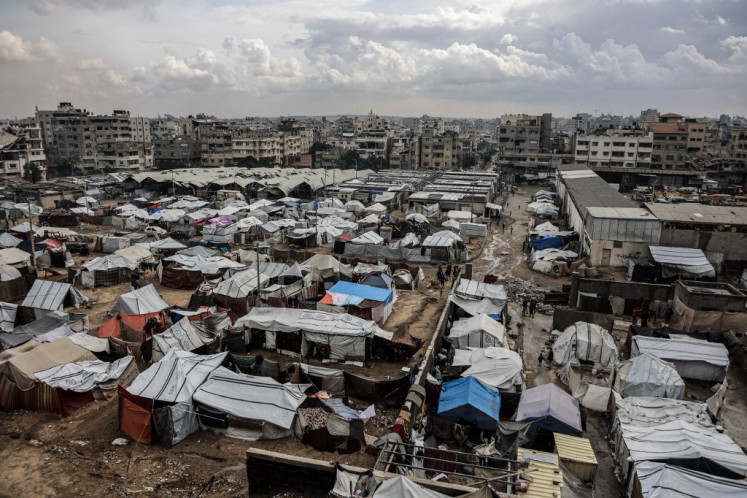Popular Reads
Top Results
Can't find what you're looking for?
View all search resultsPopular Reads
Top Results
Can't find what you're looking for?
View all search resultsHousing for the poor: The Kampung Deret lesson
The growth of the urban population has generated many problems, including a lack of housing for those who are poor
Change text size
Gift Premium Articles
to Anyone
T
he growth of the urban population has generated many problems, including a lack of housing for those who are poor. Most poor urban residents in Jakarta live in makeshift slums or squatter settlements.
The marginalized have resorted to occupying state land such as dumpsites, riverbanks or railway tracks, as well as private unoccupied land, where they illegally construct their dwellings.
Housing for the urban poor, who currently live in informal settlements, is one program of many on the agenda for Jakarta Governor Anies Baswedan. During his campaign, Anies said he would not evict residents of informal housing settlements but would instead build rumah lapis (vertical and layered housing) for them on their land.
The idea of rumah lapis is not new in the literature on upgrading housing settlements for the urban poor. To some extent, the initiative replicates the kampung deret (elevated village) program implemented by former Jakarta governor Joko “Jokowi” Widodo in October 2013.
The kampung deret program replaced substandard, unsafe and unsanitary housing in Jakarta’s informal settlements with permanent housing. The program built nearly 4,500 permanent homes for the urban poor in Jakarta in less than a year.
But the Jakarta administration discontinued the program at the end of 2014, citing a lack of support from the city council, particularly in budget allocation, and legal issues plaguing the land occupied by the urban poor.
The concept of rumah lapis and kampung deret is rooted in John Turner’s seminal book Housing by People: Towards Autonomy in Building Environments (1977). Turner argued that housing is not only a commodity but also a process or activity, and that the establishment of desirable housing standards is absurd. Slum clearance programs only move substandard houses to new places, particularly to the urban periphery.
There is no need to demolish slums because they are part of the solution. Turner’s idea of self-help was used to implement the upgrading and consolidation of the homes of slum dwellers. He identified that perceived security of tenure would result in the progressive upgrading of slums through individual and community self-help.
In situ upgrading represents an incremental improvement to the delivery of housing (Mistro and Hensher, 2009). In situ upgrading aims at minimizing the number of slum dwellers that are relocated to another site and reduce disruption to the social and economic networks of slum dwellers.
One of the primary requirements of the kampung deret program was establishing the legality of land tenure. Dwellers needed to show evidence of formal or semi-formal land tenure to be eligible for the program.
The city administration would grant land titles to dwellers with informal land tenure if they had resided on the same plot of land for more than 20 years. The program assisted dwellers to obtain land titles and housing certificates. The kampung deret program received significant support from residents because the program offered them land titles.
The city administration was able to give the dwellers legal titles on the lands they occupied in the first few cases of the kampung deret program, but they failed to sustain the effort because of the complicated process of land titling. The program was finally discontinued because the city administration was not able to identify slum dwellers who occupied land with legal land titles.
The city administration identified the locations for the program that were set to become residential areas in the 2030 Jakarta Spatial Plan. The Jakarta Housing and Public Building Agency identified at least 392 settlements that could be considered as slums but many were not qualified for the program, such as residents of Bukit Duri, because their area was demarcated as a green area in the 2030 Jakarta Spatial Plan.
The planning process of the program started with a collaboration between neighborhood leaders and city officials. Priority was given to residents who lived in detached semi-permanent houses in flood prone, unsanitary or very dense areas. The city administration hired consultants to facilitate the program.
The consultants were assigned to assist the beneficiaries in every stage of the kampung deret program. They also mediated in the design and construction of housing, working closely with the programs beneficiaries. The beneficiaries were responsible to find and rent temporary accommodation while their housing was being upgraded or built.
The construction or upgrading of the housing took about three months. Construction was efficient because it adopted standardized and fabricated building materials, dubbed the rumah instan sederhana sehat (instant simple healthy home).
Legalizing land tenure is not a solution for upgrading the housing of Jakarta’s slum dwellers. It is not legal land titles, but rather the perception of secure land tenure that is most important for the sustainability of the kampung deret program. The security of land tenure can be given to Jakarta’s slum dwellers by tolerance and discretion in Jakarta’s spatial plan. The plan needs to integrate Jakarta’s slum settlements into the formal and legal system.
The approach of menata tanpa menggusur (upgrading without displacing) was the key ingredient of the kampung deret program. In situ upgrading is appealing to Jakarta’s slum dwellers. In situ upgrading in the kampung deret program reduced disruption to the social and economic networks of the urban poor.
Governor Anies should develop his rumah lapis program based on the kampung deret program. The strengths and weaknesses of the latter will help the current city administration make a success of the rumah lapis program.
Upgrading housing in Jakarta’s informal settlements also needs a broader development strategy to combat poverty and inequality.
To be effective, the rumah lapis program, or other settlement upgrading programs, must be incorporated into a community development strategy that addresses employment, transportation, education, health services and access to formal financial services.
____________________________
The author is professor and coordinator of the graduate program in Urban Studies and Planning at Savannah State University, Georgia, the United States.










